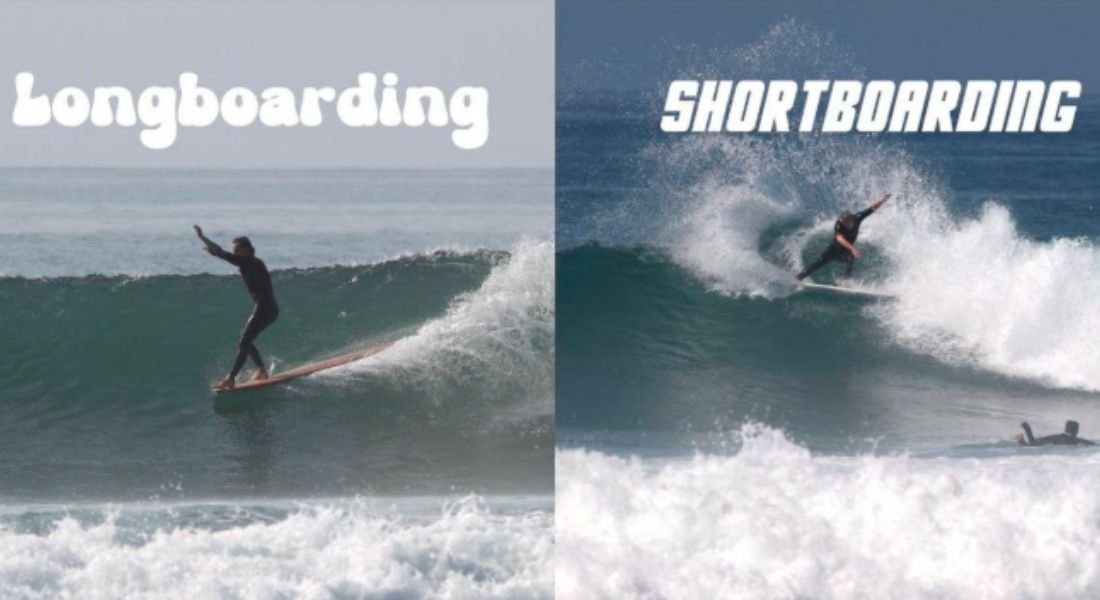A longboard suits beginners and relaxed surfers who want easy paddling, stability, and smooth rides — ideal for small waves. A shortboard suits intermediate to advanced surfers chasing speed, sharper turns, and performance in faster, steeper waves. Your skill level, local surf, and style should guide the choice.
Choosing the wrong surfboard can stall your progress and kill your stoke. Many new surfers jump on a shortboard too soon and struggle to catch waves or stay balanced, while others stick to longboards and miss out on sharper turns and faster manoeuvres. Picking the right board for your skill level and wave conditions makes all the difference between frustration and fun.
So how do you know which one will actually help you enjoy more time in the water — and less time wiping out?
What’s the Difference Between a Shortboard and a Longboard?
The difference between a shortboard and a longboard lies in their length, shape, and performance. Shortboards are usually under 7 feet, narrow, and more curved (known as rocker). Longboards are 8 to 10 feet long, wider, and flatter, offering more surface area and stability. These variations affect how each board paddles, turns, and performs on different types of waves — and they even influence how you store them at home, with longboards often needing a larger surfboard rack to keep them safe and secure.
Who Should Use a Longboard?
Longboards are ideal for beginners and surfers who prefer a smooth, relaxed ride. Here’s why:
- Easier to Paddle: The extra length and width of a longboard make paddling easier and catching waves more forgiving. If you’re just starting out, this matters a lot.
- Greater Stability: Longboards are more stable, which means you’re less likely to fall off while learning to stand, balance, and turn.
- Better for Small or Slow Waves: If you’re surfing mellow beach breaks or slower point breaks, a longboard lets you catch waves earlier and ride them for longer distances.
- Classic Surf Style: Longboards support a flowing, traditional style of surfing, including nose riding and cross-stepping. When you’re not in the water, a well-placed board rack keeps your longboard safely stored and ready for your next session.
Who Should Use a Shortboard?
Shortboards are suited for intermediate to advanced surfers looking for speed, sharp turns, and high-performance manoeuvres.
- Greater Control for Turns: The narrow shape and rocker design allow for tighter turns, cutbacks, and snaps in the pocket of the wave.
- Built for Bigger, Steeper Waves: Shortboards excel in fast, hollow waves where quick response and manoeuvrability are key.
- Lightweight and Portable: They’re easier to carry, travel with, and fit in smaller vehicles, making them practical for mobile surfers — just throw it in the car with your fins, leash, and wax case, and you’re good to go.
- Designed for Progressive Surfing: If you’re looking to do tricks, airs, or vertical drops, the shortboard gives you the control and responsiveness you need.
Pros and Cons at a Glance
| Feature | Longboard | Shortboard |
|---|---|---|
| Length | 8–10+ ft | Under 7 ft |
| Stability | High | Lower |
| Paddle Speed | Easy | More effort |
| Wave Type | Small/slow | Fast/steep |
| Skill Level | Beginner-friendly | Intermediate+ |
| Manoeuvrability | Low | High |
| Travel-Friendly | Less | More |
| Style | Classic & smooth | Aggressive & sharp |
How to Choose: Shortboard or Longboard?
To decide between a shortboard or a longboard, ask yourself the following questions:
1. What’s Your Experience Level?
Beginners generally do better with longboards. The stability, easier paddling, and smoother rides make it simpler to learn the basics and build confidence.
Intermediate and advanced surfers may prefer shortboards for more responsive handling and wave performance. If you’re already catching waves consistently and looking to challenge yourself, a shortboard can open new doors.
2. What Are the Waves Like in Your Area?
Small, mushy waves = Longboard. The extra length helps you catch waves earlier and stay on them longer, even in weak surf.
Steeper, faster waves = Shortboard. The design helps you drop into waves quickly, handle tight turns, and stay in control at high speeds.
3. What’s Your Surfing Style?
Do you enjoy graceful rides, walking the board, and cruising? A longboard suits that classic, flowing style. It’s ideal for mellow point breaks and beach breaks.
Do you want sharp turns, fast movement, and vertical drops? Then shortboarding is your lane. It’s better for surfers who like speed, power, and precision.
4. Are You Focused on Progression or Fun?
Some surfers stick with longboards forever simply because they’re fun, low-stress, and great in most conditions.
Others chase progression, tricks, and competition, which leads them toward shortboards for their performance potential. If you see yourself experimenting with aerials or tight turns down the line, a shortboard will give you more room to grow.
Can You Use Both?
Yes — and many surfers do. Building a quiver, or surfboard collection, is common once you’re more experienced. Having a longboard for mellow summer waves and a shortboard for punchier days gives you flexibility and helps you get the most out of every session.
If you’re serious about improving your surfing or want to enjoy different wave conditions, it might be worth having both options over time.
Ride What Matches Your Style and Skill
At the end of the day, the best surfboard for you isn’t about trends or what other people are riding — it’s about how you want to experience the waves. A longboard gives you stability, flow, and easier access to smaller surf. A shortboard opens the door to faster turns and more dynamic moves, but it comes with a steeper learning curve. Matching your board to your skill level, local conditions, and surf goals ensures every session builds confidence rather than frustration.
Still unsure? Don’t rush the decision. If possible, try both before committing — hire, borrow, or demo boards to feel the difference. The more you surf, the clearer your preferences will become. And remember, you’re not locked into just one board. As your skills grow and your style evolves, your surfboard can too. The goal is simple: ride what keeps you smiling in the lineup.









